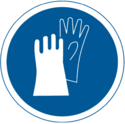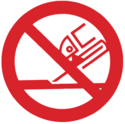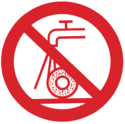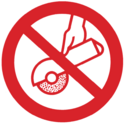Safety
Safety in the use of Grinding Wheels
Safety instructions (PDF)FEPA safety instructions (PDF)
Stringent safety standards are maintained throughout the manufacture of COMET wheels. To reduce the risk of accidents further, the law requires that certain basic precautions are taken in the storage and use of abrasive wheels.
1. Receipt, Handling, Storage and Inspection of Grinding Wheels
- On receipt, grinding wheels should be examined to see if they show any signs of damage, such as chips, cracks or discolouration. Damaged wheels must not be used.
- All grinding wheels can be damaged by any mishandling that results in the wheel being subjected to any shock loading. This can occur due to product being inadvertently dropped, knocked over or banged against any other object. This is equally true if the wheel is secured on a pallet which has been dropped heavily from a fork lift truck.
- Any grinding wheel subjected to such mishandling should be carefully examined for sings of damage. If in any doubt - do not use.
During storage, grinding wheels must not be subjected to: - Exposure to humidity, water or other liquids
- Freezing temperatures
- Any temperature low enough to cause the formation of condensation on the wheels when moving from storage
to an area of high temperature. - The outer surfaces of certain organically bonded wheels may be affected by oxidation if they are stored for long
periods. These types of wheel should not be stored for more than two years and stock control should ensure that older wheels are used first.
2. Mounting
- It is statutory requirement that the person who mounts grinding wheels on the grinding machine shall be a trained and competent person appointed by the factory occupier.
- A wheel should only be mounted on the machine for which it was intended.
- All grinding wheels should be closely inspected before mounting to ensure that they have not been damaged whilst in storage or transit.
- The ring test should be carried out in a place where the ring can easily be heard.
- The speed of the spindle on which the wheel is mounted should not under any circumstances exceed the maximum speed specified for the wheel.
- Bushes should not project beyond the side of the wheel and the wheel blotter when used. The wheel should fit freely, but not loosely, on the spindle.
- Wheels, blotters and flanges should be free from foreign matter.
- Blotter should be used with all grinding wheels unless there is a specific exception. They should be slightly larger than the mounting flanges and free from wrinkles.
- Mounting flanges are designed to clamp the wheel to the machine and transfer the driving forces from the machine spindle to the grinding wheel. They should be designed to take the driving forces away from the surfaces of the grinding wheel hole and be not less than one third of the grinding wheel diameter.
- Flange surfaces should be flat and free from burrs.
- Flanges should be of equal diameter, have equal bearing surfaces and be properly recessed or undercut.
- The rear flange must be fixed to the machine spindle.
- Flanges must run true to the machine spindle.
- Clamping nuts should only be tightened sufficiently to hold the wheel firmly. When flanges are clamped by a series of screws, they should be tightened uniformly in diametric sequence. Bolts for mounting wheels with inserted nuts should be long enough to engage an adequate length of thread, i.e. equal to the thread diameter, but must be not protrude through the nut insert. For recommended designs of flanges, refer to the FEPA Safety Code.
3. Operating Precautions
After mounting or re-mounting a grinding wheel on a machine, stand well clear and allow the wheel to run free for a short period. A remounted wheel should always be treated as a new wheel.
- No abrasive wheel should be operated at a speed in excess of the maximum permissible speed specified for that abrasive wheel.







